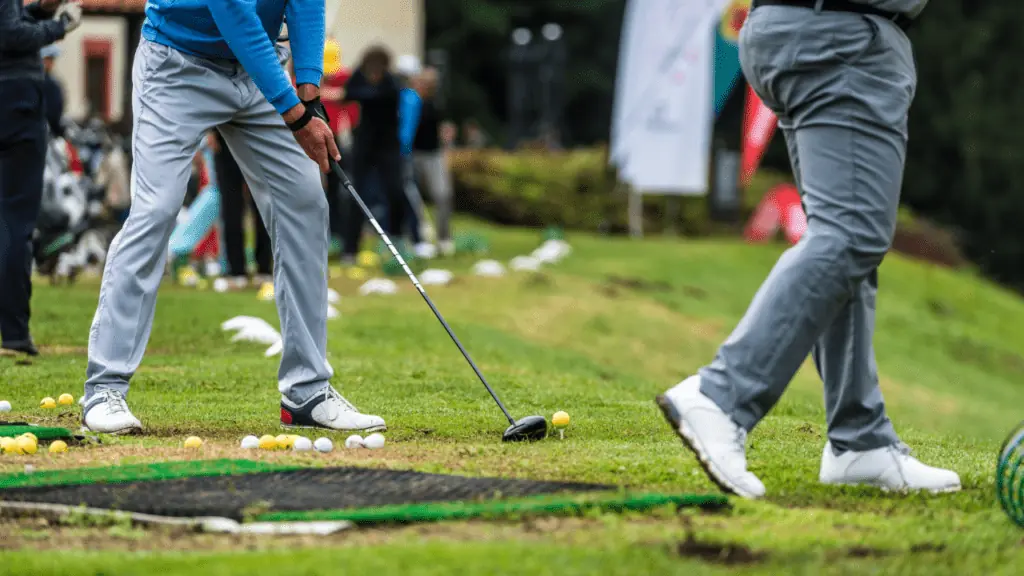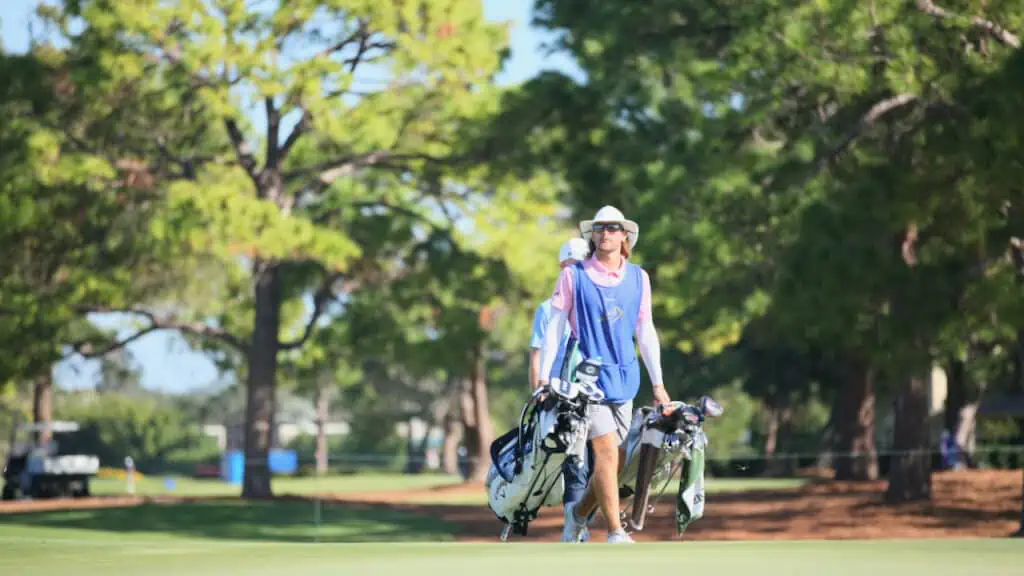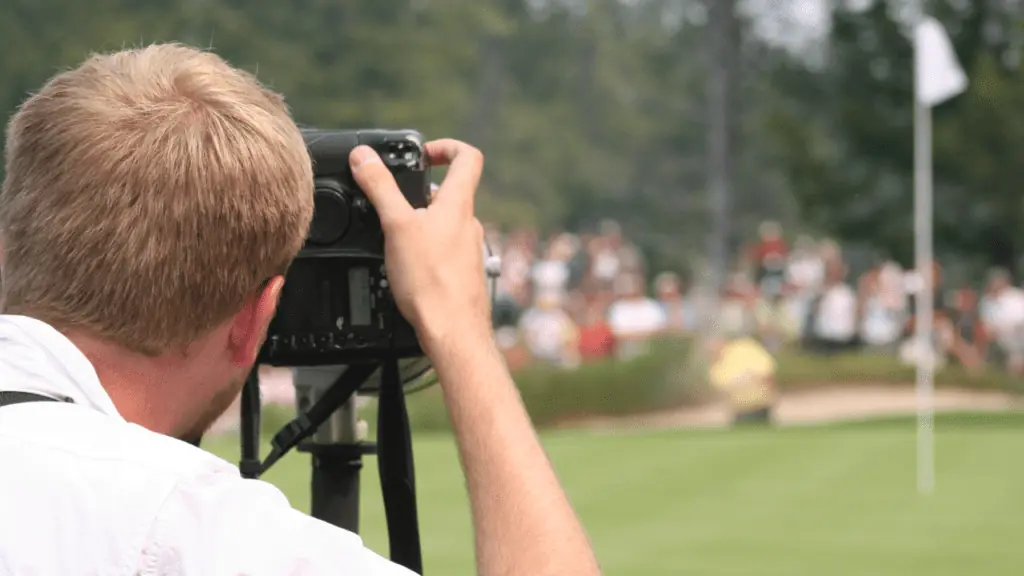Table of Contents
In this golf tournament guide, we cover the core basics of how to prepare for a golf tournament in 16 simple golf tournament tips. Read on, for valuable information on keeping you golf fit and focused on the golf course.
I have played golf tournaments since I was 6, ranging from 9 hole local junior competitions to the World School Golf Challenge. Based on my experiences, I will show you how to prepare for a tournament and be the best version possible.
By the end of this post, you will know precisely how to prepare for a golf tournament, practice with a purpose, and eat correctly. Plus, I will explain why I recommend hiring the services of a caddie for tournament golf and how to warm up correctly.
Prepare for Various Golf Weather Conditions
Whenever I am down to play a golf tournament, I start by thinking about the possible golf weather conditions and what clubs I may need. When the course is a green parkland layout with restricted roll on the fairways, I opt for a higher launching hybrid club instead of longer irons to maximize carry distance.
Conversely, if I am playing a links course where the wind is bound to blow, I consider my low-launching long irons. Now, if you do not have a selection of clubs to pick from, no problem. Stick to what works for you but be mindful of how the conditions will impact the flight, roll, and distance.
Simulate Your Round On The Range

Before a tournament, I like to envision the ideal round on that course and simulate it on the driving range. For example, if the first hole is a 350 yard par 4 that doglegs to the right, I may strike an easy long iron or hybrid to the left of the fairway, leaving myself 150 yards to the flag.
Since I hit a 7 iron 150 yards, I would pull it out and strike a full shot to replicate the experience. Repeat the process until you have run through all 18 holes. If you are scheduled to tee off the 10th hole, start your training by simulating your intended shot on this hole and run through the exercise until you complete the 9th hole.
Prepare For The Worst (Practice Escape Shots & Prepare For Delays)
The challenge I see with most amateur golfers is they always practice as if every shot on the golf course is an effortless full strike. You may have to play shots from behind a tree, in the bunker, or beside the water. This is vital to avoid disaster and have more quality tools in your golf game.
Prepare for the worst and practice sneaky escape tricks with a left-handed bladed shot or hitting backward with one hand. These are lesser-used shots, but they are handy in extreme circumstances. However, more common escape methods include punches and bunker shots.
A punched shot is essential for keeping your golf ball low when you see overhanging branches in your line. A punch shot keeps the ball down and helps you exit the woods and enter the fairway. The inability to play a punch shot in a tournament can be costly and take you several strikes to escape the woods and add strokes to your score.
Bunker shots, both fairway and greenside, are worth spending time on to help you get out of the sand and back into play. Greenside bunkers require greater precision to help you get up and down and avoid leaking strokes.
Take a Golf Lesson to Work On Specific Weaknesses
When I have a specific issue bothering me before a tournament, I visit my golf coach and ask him to focus on that area. This helps me avoid making unnecessary changes to other parts of my game before a big day.
However, the lesson helps me identify a few vital mistakes to help me better identify and correct them during the tournament. A technical golf lesson at this point may have the coach changing multiple facets of the setup and swing, which can wreak havoc with your swing.
On an occasion, as a junior, I visited a coach three months before the World School Golf Challenge. Since the golf coach had played on the European and Sunshine Tour, I figured it could only be good for my game.
However, the gentleman changed everything about my golf grip, swing, and setup, which I had adapted to over 14 years. These changes came at the wrong time, and it felt like I had forgotten how to hit a golf ball. Needless to say, the World School Golf Challenge is a tournament I would like to forget.
Work Equally on Your Long, Mid, and Short Game

For some reason, amateur golfers neglect their short game practice to focus on long-game work. Whenever I hit the driving range, I am gobsmacked at how easy it is to find a spot on the green but not the hitting bays.
Do not make the same mistake. Divide your practice time equally between long, mid and short game practice. You need a balanced performance to keep your strokes down because neglecting one area may prove costly.
I suggest dedicating one 2-hour range session weekly to woods and iron play and another session to wedges and putting. For your long game, work on the shots most likely to be used in the tournament. For example, straight strikes, draws, or fades.
Cover chip shots, pitch shots, flops, bump and runs, and bunker shots during your short game greenside practice. In addition, spend time refining your stroke on short, makeable putts, and enhance your consistency on lag putts.
⛳️ Read Next: 9 Best Putting Drills For Beginners To Master The Green
Golf Nutrition | Eat Correctly Before the Game
Eating the right foods is another key component often overlooked on how to prepare for a golf tournament.
For optimal performance in your golf competition, your body needs to run on the correct fuel. Ensure you eat a balanced diet of protein, vitamins, minerals, and healthy carbohydrates, leading to competition day.
Equipping your body with the correct nutrients results in better energy to boost swing speed and power and resist fatigue.
I always found it better to eat a light meal before a round to avoid the possibility of stomach cramps or stitches. Pack your golf bag with nuts, raisins, and bananas to keep your energy levels up through the game. You can always reward yourself with a hearty meal at the end of the tournament.
Besides food, always keep cold water in your bag and take a couple of sips after each hole. Drink moderately to maintain hydration, rather than downing it all in one go feeling bloated, and risking a stitch.
Play Practice Rounds
I always found it handy when possible to play practice rounds on the golf tournament course a day or two before. Sometimes it is not possible, but it is a great help. This allows you to explore the best route to the flag on every hole, identify hazards, lay-up points, and the slopes on the greens.
If time is limited and a round is out of the question, try walking or taking a cart around the course a day or two before to scope it out.
Arrive Early for Golf Warm Up Exercises
Ensure you arrive earlier to the course than you would for a casual round. I find 90 minutes before tee-off is a healthy time. Showing up in advance alleviates the stress and rush of running for the tee box unprepared.
I find it gives you ample time to check in at the Pro Shop, identify your foursome, and do a last-minute check on your equipment stock. Once your bag is ready for action, proceed to the driving range, if there is one, and start warming up.
If you carry a swing plane trainer, use the aid to warm up and activate your core golf muscles. Plus, utilize the training aid to induce a rhythmic swing with optimal rotation and power. Once your core muscles are awakened, proceed to the practice green and warm up your putting stroke. If you need some warm up exercise examples, you may want to read our article senior golf exercises.
You can do all this and still make it to the tee with time to spare when you arrive early for your round.
⛳️ Read Next: 20 Best Golf Training Aids [Golf Expert Review]
Have Enough Tees and Balls
Always check your stock before you start warming up, and purchase more golf balls and tees if you need them. The last thing you want is to run out of golf balls and have to post a did not finish (DNF) because of a rookie error.
Traversing the golf course with enough golf tees and balls helps you relax and eradicates one worry in your mind.
Always Mark Your Ball
I have witnessed many blowouts on golf courses between players who accuse each other of striking the wrong ball. It happens frequently and can easily be avoided. Carry a marker pen in your bag and ensure that you place an easily identifiable mark on each ball.
It can be as simple as a dot or a line. However, I prefer to take no chances and scribble my initials on the ball. This stops me from hitting the wrong ball and angering my fellow players and helps me endure the same fate.
Why You Should Hit the Practice Range & Putting Green
I have seen commentators suggest against hitting the range or putting green before a round. I understand their concerns but disagree. Their thinking is that should you hit a few poor shots or putts, it will put you in a negative frame of mind and ruin your round.
However, I believe the purpose of this task is to loosen up and get your eye in. You should avoid thinking about technicalities and how well you are striking the ball. Get your muscles activated and your hips and shoulders turning. Forget about how far you hit the golf ball, as that is not the purpose of a warm-up.
Admittedly, some of my thinking stems from powerful words from Tiger Woods’s father, Earl. He said your mission before a round is to warm up and nothing else. As long as you are warm once you step off the practice tee or green, that is all you should care about.
🏌️♂️ Read Next: 18 Best Golf Books of All Time | Golf Expert’s Top Picks
Warm Up and Stay Warm
I mentioned that arriving at the course early before a golf tournament allows you time to warm up and activate your core golf muscles. I find a swing plane trainer such as the Orange Whip or SKLZ Gold Flex are handy golf training aids for warming up.
However, if you are without a training aid, grab the head of your driver, and hold it with the grip closest to the turf. While holding the club, swing it back and forth effortlessly and watch how your shoulders and hips start to turn and synchronize with the rest of your body.
Once you are warm, the trick is to stay warm. On tournament days, the field is often packed to the rafters resulting in delays between shots. Instead of losing focus and cooling down, I suggest swinging your driver back and forth while you wait to keep warm and powerful.
Take a Caddie

Caddies have proved invaluable to me throughout my life and helped me immensely. I always suggest taking a caddie for a tournament round because they provide local knowledge and guidance and relieve you from the weight of your golf bag to conserve energy during the competition.
In addition, caddies give you a leg up on your competitors because they advise where to aim and assist with putting lines. Furthermore, they keep your golf clubs clean and ready for action on each shot. Finally, a caddie helps you find your golf balls faster and relieves the stress of wasting your rival’s time.
Aim for the Middle Green
My suggestion for golf tournament play is to aim for the middle of the green and avoid doing anything too risky. By focusing on the center of the green, you leave yourself room for error if you pull or push your shot.
However, when you attack the flag, it requires optimal precision, and if you miss, you could find yourself with a tricky up and down. Although hitting the middle of the green is boring, it is better facing a 30-foot birdie putt than a challenging bunker shot.
Skip the Clubhouse and Stretch
I spoke about keeping warm earlier, and the clubhouse is the worst enemy of in-form golfers. When you stop for 15 minutes to have a hot dog and a coke, your muscles cool down and lose all the stretching from the front nine.
Since hot dogs are not that healthy for you, you might think of skipping the clubhouse and using the time to eat a sandwich from home and keeping your body warm. Continue swinging your golf training aid or hit a couple of putts to keep you focused.
Skipping the clubhouse will keep you in the groove and your core golf muscles awakened while your foursome starts relaxing.
Treat it Like a Casual Round

If you are entering your first golf tournament, you will be nervous, which is fine. However, take the tournament as another round of golf. There may be more players and advertising banners littered around the course. However, your only competition is staring back at you from the mirror.
Do not stress yourself and stay positive. Follow your routine, relax, swing easy, and keep those muscles warm. I play competitive golf better when I enter this mindset; treat it the same for every round to neutralize anxiety over the level of the event.
For more information on mastery of the golf mental game or extreme golfing nerves, you’ll want to check out our article on the Golf Mental Game.
Final Thoughts
The 16 golf tips above teach you how to prepare for a golf tournament, enjoy yourself and deliver the best results. There is no single formula to success, and each golfer has a range of tricks that work for them.
However, the most necessary steps for preparing for a golf tournament revolve around practice, eating correctly, and leveraging the assistance of a caddie. In addition, it is vital that you arrive early, have a sufficient supply of golf balls and tees, and mark your ball to make it easily identifiable.
Finally, once you reach the golf course, ensure that you warm up and activate your core golf muscles for optimal power in your golf swing.
FAQs | How to Prepare for a Golf Tournament
What is the best thing to drink when playing golf?
Water is truly the best drink to keep you hydrated on the golf course. Gatorade also is a good option when sweating a lot to maintain electrolyte levels. If you have particular health issues, always consult your doctor.
What is the best snack for golf?
Pack your golf bag with healthy snacks such as nuts, raisins, and bananas to keep your energy levels up through the golf game. It’s best to avoid unhealthy fatty foods that can affect your energy levels
How do I calm my nerves for a golf tournament?
Follow your routine, relax, swing easy, and keep those muscles warm. Make sure you continue to breathe; often we tend to hold our breath and forget to take deep breaths through the nose.

